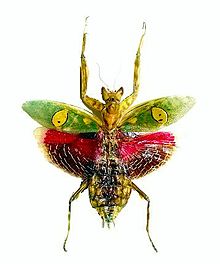- Creobroter
-
Flower Mantis 
Creobroter gemmatus Scientific classification Kingdom: Animalia Phylum: Arthropoda Class: Insecta Order: Mantodea Family: Hymenopodidae Subfamily: Hymenopodinae Tribe: Hymenopodini Genus: Creobroter Species see text
Creobroter or Flower Mantises is a genus of mantis concentrated in Western Asia. The name comes from the Greek "kreas" (combining form "kreo-", meaning "flesh"), and "broter" (eating); therefore, "flesh-eating", an apt name for a predatory insect. Both sexes have long wings and are capable fliers. Full-grown males are about 3 to 4 cm in length, females about 4 to 5 cm.[1][2]
Contents
Camouflage and mimicry
 Preserved Creobroter gemmatus with open wings
Preserved Creobroter gemmatus with open wings
As the common name indicates, Creobroter are known for having varicolored (yellow, white, red, brown, etc.) markings which serve as camouflage by hiding the creatures' actual shape and making them look somewhat like flowers when hiding amidst green foliage.[2][3]
The resemblance to flowers may be greater in sub-adult Creobroter than those that are fully grown. In any case, this flower-mimicry is less extreme than that of the orchid mantis, but is attractive enough to make Creobroter favored by people who raise exotic insects as pets, especially as Creobroter species are more common and a bit less delicate than the more flower-like Hymenopus.[1][2][4][5]
In the case of some Creobroter (such as the C. gemmatus shown at the left) these markings also serve as eyespots when the mantis spreads its wings in a threat display.[6]
Rather than resembling foliage or flowers, some species of Creobroter resemble ants during the their early nymph stages. Ant mimicry is a useful defense against predation for the young Creobroter as most ants are relatively unpalatable and aggressive making insect predators that rely on vision to identify their prey, such as birds and wasps, avoid them.[2]
Around their third ecdysis, Creobroter trade their ant-mimicking dark, shiny appearance for the green and light-colored markings that make their outline so difficult to discern amidst vegetation.[2]
Species
There are just over twenty species of Creobroter described including the following:[2][7]
- C. elongatus (Beier, 1929)
- C. fasciatus (Werner, 1927)
- C. gemmatus (Stoll, 1813)
- C. medanus (Giglio-Tos, 1915)
- C. meleagris
- C. nebulosus (Zheng, 1988)
- C. pictipennis (Wood-Mason, 1878)
- C. urbanus (Fabricus, 1775)
See also
Bibliography
- For a technical discussion of an aspect of this genus' anatomy refer to The cervical sclerites of Mantodea discussed in the context of dictypoteran phylogency by Frank Wieland, Entomologische Abhandlungen 63, Museum fur Dresden, 2006
References
- ^ a b "Creobroter Elongata, Gemmatus, Meleagris, Pictipennis". Mantisinc. http://www.mantis-inc.co.uk/creobroter.htm. Retrieved 2007-01-19.
- ^ a b c d e f "Creobroter". Mantis Online. http://www.mantisonline.eu/view/species/mantids/creobroter/index.php. Retrieved 2007-01-19.
- ^ "Creobroter gemmatus". Them Bugs. http://www.thembugs.com/retail/store.php?crn=206&rn=406&action=show_detail. Retrieved 2007-01-19.
- ^ "Indian Flower Mantis". Central Pets.com. http://centralpets.com/animals/insects/praying_mantis/pry5994.html. Retrieved 2007-01-19.
- ^ Regarding this insect in captivity, one expert speculates that
the nectar-fed insects that the flower mantis does consume have high caloric content. Because many people feed captive Indian flower mantises crickets, they may not receive proper nutrition content. More research is needed to confirm this proposition. Regardless, it is best to feed your flower mantis a varied diet.
- ^ This photo link reveals not only how C. gemmatus displays its eyespots but also shows the surprising ruby-red color of its second wing pair from which this species may have derived its Latin name.
- ^ There is no consistency for the use of English language common names for these species. For example, at least two Creobroter species found in India have been called "Indian flower mantis." Conversely, a Creobroter collected in Thailand might be displayed in a collection as a "Thai flower mantis" while the exact same species collected on the other side of that country's southern border might be displayed elsewhere as a "Malaysian flower mantis". Rather than make arbitrary decisions in this regard and giving one common name more weight than another, this article lets binomial nomenclature serve its intended and very useful purpose.
Categories:
Wikimedia Foundation. 2010.
